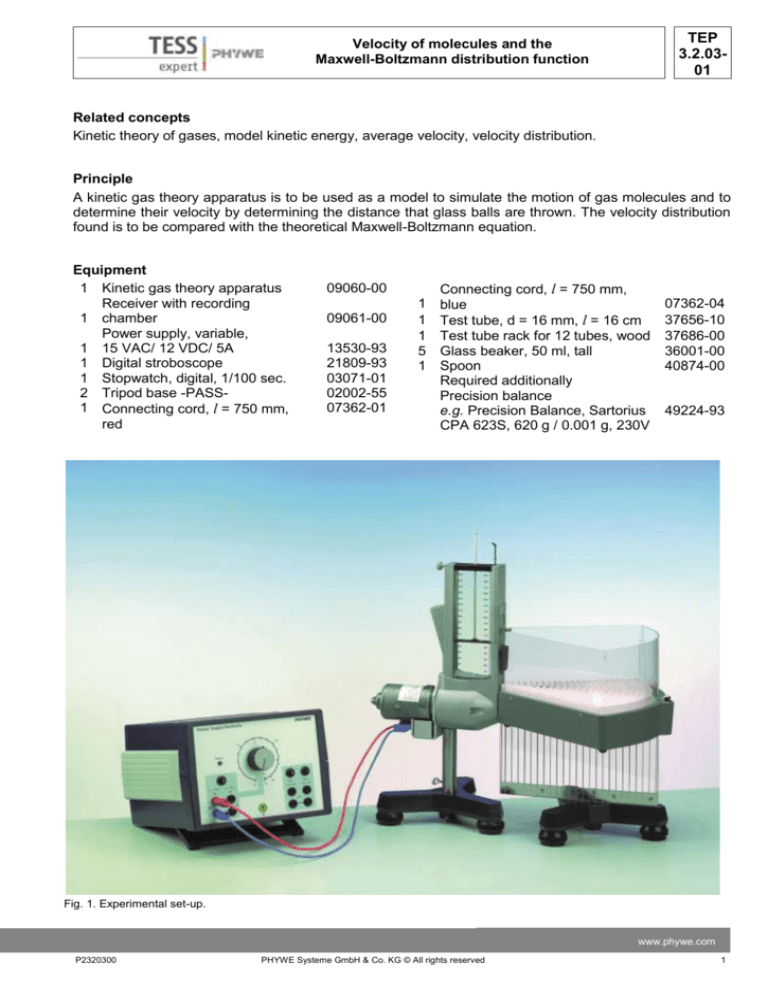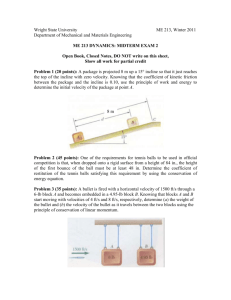
TEP
3.2.0301
Velocity of molecules and the
Maxwell-Boltzmann distribution function
Related concepts
Kinetic theory of gases, model kinetic energy, average velocity, velocity distribution.
Principle
A kinetic gas theory apparatus is to be used as a model to simulate the motion of gas molecules and to
determine their velocity by determining the distance that glass balls are thrown. The velocity distribution
found is to be compared with the theoretical Maxwell-Boltzmann equation.
Equipment
1 Kinetic gas theory apparatus
Receiver with recording
1 chamber
Power supply, variable,
1 15 VAC/ 12 VDC/ 5A
1 Digital stroboscope
1 Stopwatch, digital, 1/100 sec.
2 Tripod base -PASS1 Connecting cord, l = 750 mm,
red
09060-00
09061-00
13530-93
21809-93
03071-01
02002-55
07362-01
1
1
1
5
1
Connecting cord, l = 750 mm,
blue
Test tube, d = 16 mm, l = 16 cm
Test tube rack for 12 tubes, wood
Glass beaker, 50 ml, tall
Spoon
Required additionally
Precision balance
e.g. Precision Balance, Sartorius
CPA 623S, 620 g / 0.001 g, 230V
07362-04
37656-10
37686-00
36001-00
40874-00
49224-93
Fig. 1. Experimental set-up.
www.phywe.com
P2320300
PHYWE Systeme GmbH & Co. KG © All rights reserved
1
TEP
3.2.0301
Velocity of molecules and the
Maxwell-Boltzmann distribution function
Tasks
1. Measure the velocity distribution of the “model gas”.
2. Compare the result to theoretical behaviour as described by the MAXWELL-BOLTZMANN distribution.
3. Discuss the results.
Set-up and procedure
Set up the experiment as shown in Fig. 1.
Fit the receiver with recording chamber to the apparatus as described in the operating instructions for the
determination of particle velocities.
First determine the average weight of one glass ball by weighing out a known number of balls (e.g. 100)
to avoid the time consuming counting of glass balls during the experiment.
Following this, determine the average number of glass balls expelled from the apparatus during 1 minute. To do this, fill the apparatus with 400 glass balls and set it to the following conditions:
— height of the upper piston: 6 cm
— oscillator frequency: 50 s-1 (controlled by the voltage and the stroboscope).
Now open the outlet for 1 minute and determine the number of balls expelled by weighing them. Refill
the apparatus with these balls and repeat the experiment twice.
Prepare for the simulation experiment by calculating the average number of balls expelled per minute
and filling this number of glass balls into each of four glass beakers. Make the following apparatus settings:
— height of the upper piston: 6 cm
— height difference between outlet and receiver: 8 cm
— number of balls: 400
— oscillator frequency: 50 s-1.
When the frequency is stable, open the outlet for 5 minutes.
After each minute, pour the balls from one of the beakers into the apparatus to maintain a constant ‘particle density’. Determine the number of glass balls in each of the 24 compartments of the receiver by
weighing.
Refill the glass beakers and repeat the experiment four times.
Theory and evaluation
According to definition, the kinetic energy of the molecules of an ideal gas is given by
Ek
m
c
2
Average kinetic energy
Mass of the molecule
Average velocity of the molecule
PHYWE Systeme GmbH & Co. KG © All rights reserved
P2320300
Velocity of molecules and the
Maxwell-Boltzmann distribution function
TEP
3.2.0301
From kinetic theory, the pressure of an ideal gas can be described by
p
r
Pressure
Density
Combining equations (1) and (2) together with the ideal gas law
Vmol
R
T
Molar volume
Gas constant
Absolute temperature
leads to the following expression for c:
or
k
Boltzmann constant
This means that the average kinetic energy is directly proportional to the absolute temperature of the gas
which is the interpretation of temperature on the molecular level.
The direct determination of the velocity of a certain molecule is impossible because collisions with other
molecules cause it to change incessantly. For a great number of molecules, a distribution function for
molecular velocities can be derived by means of statistical methods. This was done by Maxwell and
Boltzmann with the following result:
www.phywe.com
P2320300
PHYWE Systeme GmbH & Co. KG © All rights reserved
3
TEP
3.2.0301
Velocity of molecules and the
Maxwell-Boltzmann distribution function
This equation describes the probability that the velocity of a molecule is within the interval {c,c+dc}. The
corresponding distribution function for oxygen at 273 K is shown in Fig. 2 as an example.
For the velocity at the maximum cw of the curve (velocity with highest probability) the following relation
can be derived:
Introducing of equation (6) into equation (5) leads to
Note that cw ≠ c and
In the model experiment with glass balls, the velocity of the balls can be determined from the distance
thrown s:
g
h
Acceleration at the earth surface (= 9.81 ms)
Height difference between outlet and receiver
Now the experimental results (number of balls per distance thrown interval) can be displayed graphically
in the form
Ni
Δc
Number of balls in the interval i, i = 1…23
Velocity interval corresponding to Δs = 1 cm (0.078 ms)
as shown in Figure 3.
4
PHYWE Systeme GmbH & Co. KG © All rights reserved
P2320300
Velocity of molecules and the
Maxwell-Boltzmann distribution function
TEP
3.2.0301
The theoretical distribution function can be evaluated by means of equation (7) using the velocity at the
maximum of the experimental distribution as cw. The result for the example in Fig. 3 is also shown in the
diagram. The agreement between the two curves is reasonably good taking into account the model
character of the experiment.
Fig. 2: Distribution of molecule velocities of oxygen at 273 K
Fig. 3: Experimental and theoretical velocity distribution in the model experiment
www.phywe.com
P2320300
PHYWE Systeme GmbH & Co. KG © All rights reserved
5







